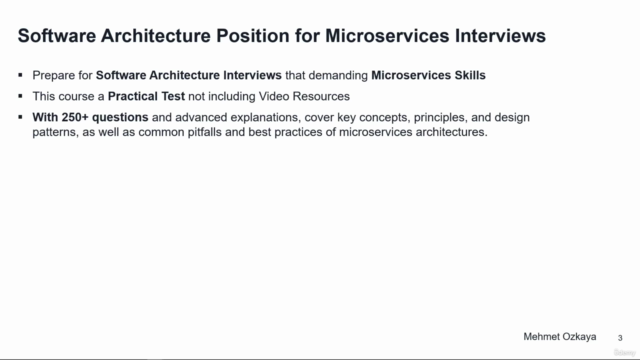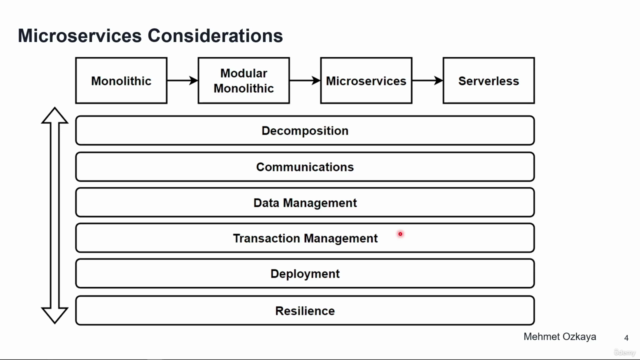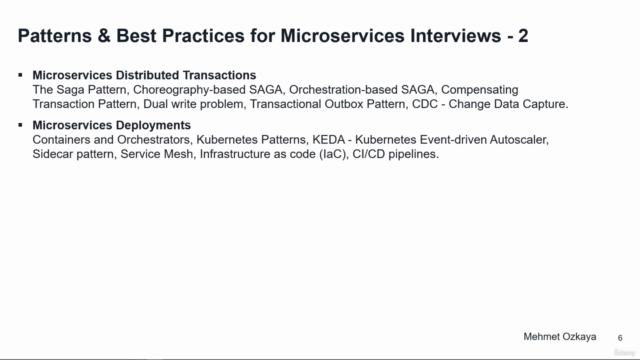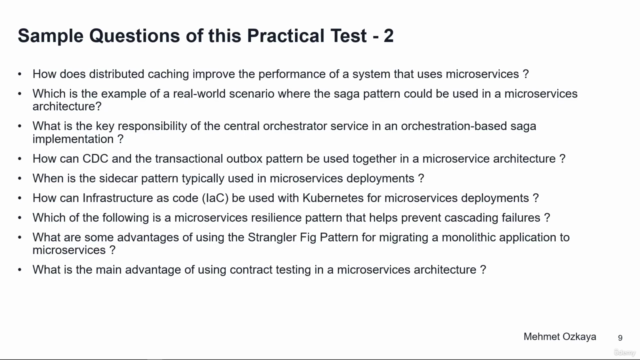Microservices Interview: Essential Questions and Answers

Why take this course?
-
Which of the following is NOT typically a responsibility of an API Gateway ?
- An API Gateway is responsible for handling various tasks such as rate limiting, authentication, request routing, composition, protocol conversion, and data transformation. However, it is not typically responsible for writing application logic or implementing business rules—those are the responsibilities of the microservices it routes to.
-
How does the API Gateway apply rate limiting in an microservices-based application ?
- An API Gateway can apply rate limiting by monitoring and controlling the number of requests a client can send to an API endpoint within a certain time frame. It enforces policies that restrict clients from exceeding a predefined limit, thus preventing overuse of resources and mitigating potential denial-of-service attacks.
-
How Service Registry and Service Discovery is used together in microservices ?
- A Service Registry stores metadata about services, while a Service Discovery tool retrieves the location (network addresses) of services from the registry. Together, they enable dynamic discovery where services can register themselves with updated information, and consumers can discover this information when needed.
-
If you design e-commerce microservice application, how you apply Publish/Subscribe Messaging Pattern ?
- In an e-commerce application, the Publish/Subscribe pattern can be applied to handle events such as inventory updates, user actions like placing an order, or price changes from suppliers. When an event occurs, it is published to a messaging system, and services that are interested in that type of event can subscribe to it and react accordingly.
-
If you decide e-commerce databases, What is the data storage technology used by the inventory microservice that processes high-velocity streams of unstructured data ?
- For high-velocity streams of unstructured data, NoSQL databases like Cassandra, MongoDB, or Apache Kafka might be used. They offer scalability and high performance for writing and reading large volumes of data.
-
Why is the Shared Database principle considered an anti-pattern for microservices ?
- The Shared Database pattern involves multiple services sharing a single database. This can lead to tight coupling, increased complexity, and potential contention and performance issues. It also violates the microservice design principle of bounded contexts and high cohesion within each service.
-
Which type of database is best suited for a microservice that handles orders and transactions in an e-commerce system ?
- For order processing and transactional operations, a relational database like PostgreSQL or MySQL might be best suited due to their ACID (Atomicity, Consistency, Isolation, Durability) properties and ability to handle complex queries.
-
How can the CAP theorem be applied in the design and implementation of microservices ?
- The CAP theorem states that a distributed system cannot simultaneously guarantee all three properties of consistency, availability, and partition tolerance. In designing microservices, one must decide which two properties are prioritized when network partitions occur. This decision impacts how services are designed and how they communicate with each other.
-
How is database sharding pattern used to improve the performance and scalability of databases in microservices ?
- Database sharding involves splitting a large database into smaller, more manageable pieces, or shards, each of which can be placed on different servers. This allows for horizontal scaling, improved performance through parallelization, and better handling of large datasets.
-
When should the materialized view pattern be used in microservices ?
- The materialized view pattern is useful when you want to store the result of a complex query or join for faster read access and avoid computation on every request. It's particularly beneficial when the same computed data is accessed frequently, which can be common in reporting microservices.
-
How can read and write databases be kept in sync in a CQRS architecture ?
- In a CQRS (Command Query Responsibility Segregation) architecture, reads and writes are handled by separate models. Synchronization can be achieved through event sourcing, where changes to the write model are published as events that update the read model accordingly.
-
Which of the following can be real-world use cases of microservices that use CQRS and Event Sourcing ?
- Real-world use cases for CQRS and Event Sourcing include e-commerce systems, online banking applications (for handling transactions), gaming platforms (for game state updates), IoT device management systems, and any system requiring a rich read model with complex aggregates that are updated infrequently.
-
API Gateway vs. Microgateway:
- An API Gateway serves as a single entry point for all client requests to the backend services and handles cross-cutting concerns such as authentication, rate limiting, and composition of responses. A Microgateway, on the other hand, is a lightweight gateway deployed at or near each service, often handling more granular concerns like local policy enforcement and cache invalidation.
-
An API Gateway might be considered an anti-pattern in scenarios where:
- The system has simple requirements, leading to overhead that doesn't justify its benefits. Or, if the services are simple enough, it might make more sense to use a microgateway instead of an API gateway for better performance and reduced complexity.
-
Enroll now and start learning today!
- This is a call-to-action to join the course or program you're describing, emphasizing the immediacy and benefits of starting your learning journey.
Course Gallery




Loading charts...